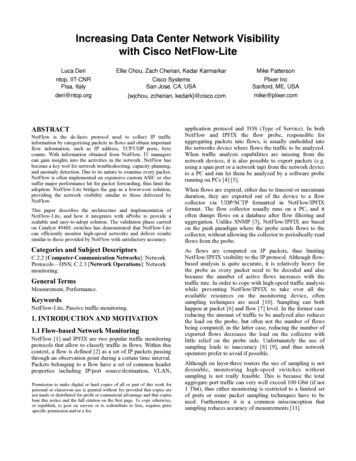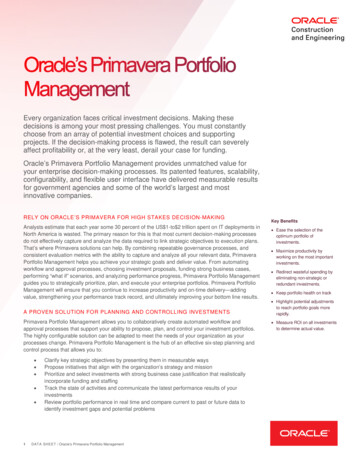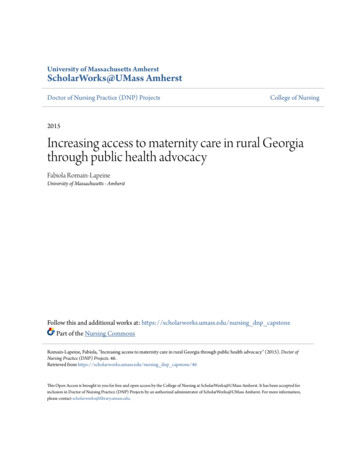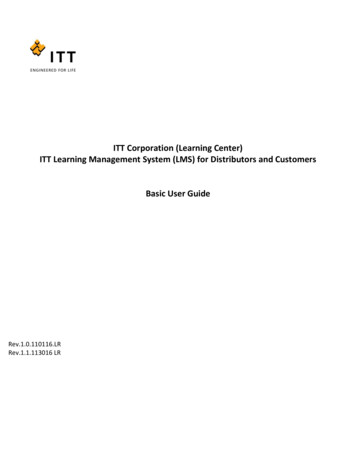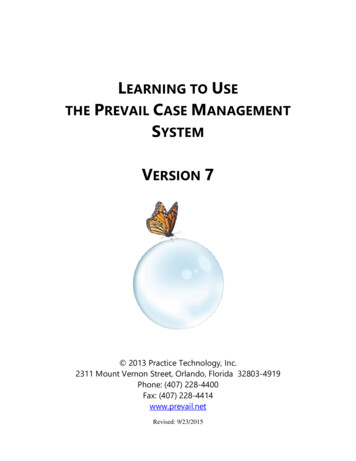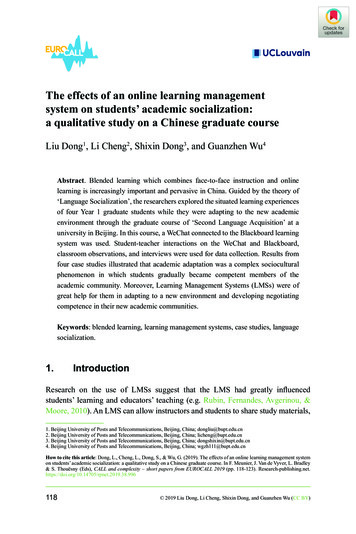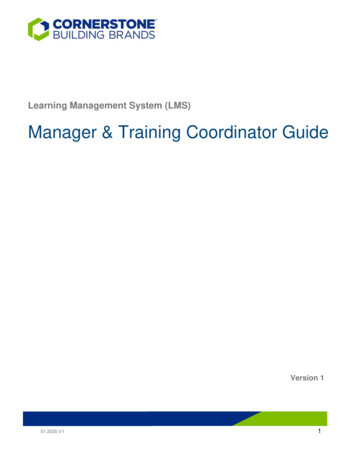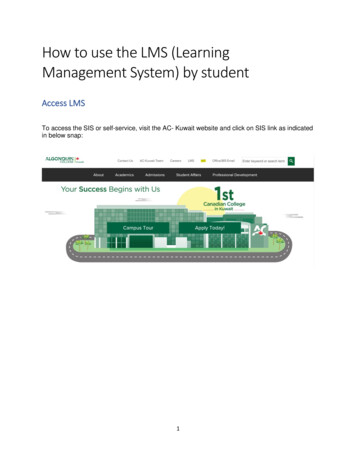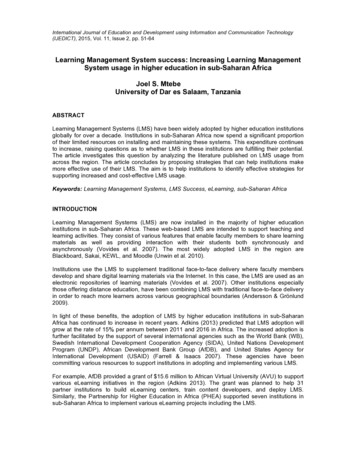
Transcription
International Journal of Education and Development using Information and Communication Technology(IJEDICT), 2015, Vol. 11, Issue 2, pp. 51-64Learning Management System success: Increasing Learning ManagementSystem usage in higher education in sub-Saharan AfricaJoel S. MtebeUniversity of Dar es Salaam, TanzaniaABSTRACTLearning Management Systems (LMS) have been widely adopted by higher education institutionsglobally for over a decade. Institutions in sub-Saharan Africa now spend a significant proportionof their limited resources on installing and maintaining these systems. This expenditure continuesto increase, raising questions as to whether LMS in these institutions are fulfilling their potential.The article investigates this question by analyzing the literature published on LMS usage fromacross the region. The article concludes by proposing strategies that can help institutions makemore effective use of their LMS. The aim is to help institutions to identify effective strategies forsupporting increased and cost-effective LMS usage.Keywords: Learning Management Systems, LMS Success, eLearning, sub-Saharan AfricaINTRODUCTIONLearning Management Systems (LMS) are now installed in the majority of higher educationinstitutions in sub-Saharan Africa. These web-based LMS are intended to support teaching andlearning activities. They consist of various features that enable faculty members to share learningmaterials as well as providing interaction with their students both synchronously andasynchronously (Vovides et al. 2007). The most widely adopted LMS in the region areBlackboard, Sakai, KEWL, and Moodle (Unwin et al. 2010).Institutions use the LMS to supplement traditional face-to-face delivery where faculty membersdevelop and share digital learning materials via the Internet. In this case, the LMS are used as anelectronic repositories of learning materials (Vovides et al. 2007). Other institutions especiallythose offering distance education, have been combining LMS with traditional face-to-face deliveryin order to reach more learners across various geographical boundaries (Andersson & Grönlund2009).In light of these benefits, the adoption of LMS by higher education institutions in sub-SaharanAfrica has continued to increase in recent years. Adkins (2013) predicted that LMS adoption willgrow at the rate of 15% per annum between 2011 and 2016 in Africa. The increased adoption isfurther facilitated by the support of several international agencies such as the World Bank (WB),Swedish International Development Cooperation Agency (SIDA), United Nations DevelopmentProgram (UNDP), African Development Bank Group (AfDB), and United States Agency forInternational Development (USAID) (Farrell & Isaacs 2007). These agencies have beencommitting various resources to support institutions in adopting and implementing various LMS.For example, AfDB provided a grant of 15.6 million to African Virtual University (AVU) to supportvarious eLearning initiatives in the region (Adkins 2013). The grant was planned to help 31partner institutions to build eLearning centers, train content developers, and deploy LMS.Similarly, the Partnership for Higher Education in Africa (PHEA) supported seven institutions insub-Saharan Africa to implement various eLearning projects including the LMS.
52 IJEDICTLMS have been successfully implemented in many institutions of developed countries. They havemanaged to improve students’ learning performance, reduce students’ dropout rates, and theyhave increased students’ satisfaction with offered courses (Naveh et al. 2012). Institutions in subSaharan Africa have been adopting them in a bid to gain similar benefits as their counterpartselsewhere. However, the context of sub-Saharan Africa is different and institutions face differentchallenges from those faced by institutions in the developed countries. As a result, the adoptionand implementation of these systems do not guarantee that institutions will enjoy similar benefitsas those institutions in the developed countries.Therefore, this study aims to investigate whether the adoption of LMS are fulfilling their potentialthrough analyzing the literature published on LMS usage from across the region. The articleconcludes by proposing strategies that can help institutions make more effective use of theirLMS. It is important to ensure that LMS implemented in sub-Saharan Africa are successful giventhe fact that any failures of LMS implementations are likely to be high on account of the limitedavailability of resources (Heeks 2002).MEASURING LMS SUCCESSStudies of LMS adoption tend to use similar metrics to those used to measure informationsystems success. Since LMS are a special type of information systems focusing on teaching andlearning (Wang et al. 2007), it is not surprising that such metrics are used. In this regard, thesuccess of an LMS adoption at a given institution can be measured in different ways. Somestudies have measured the success of LMS through measuring learners’ satisfaction with thesystem (Wang 2003; Shee & Wang 2008; Tella 2012). They have developed various instrumentsthat could be used to evaluate users’ satisfaction with the LMS. For instance, Wang's (2003)instrument consists of the learner interface, learning community, and content personalization. Theinstrument has been widely used in various studies to measure LMS success (Katsidis &Anastasiades 2008; Shee & Wang 2008).Some studies have adopted other factors such as information quality and readiness, self-efficacy,self-regulated learning, system quality, and service quality to measure users’ satisfaction with theLMS (Tella 2012; Eom 2014). Generally, users’ satisfaction has held a central role in manystudies as one of the measurements for the success of LMS. However, user satisfaction cannotbe an appropriate measure of LMS success in situation where the use of the system is notmandatory (DeLone & McLean 1992) such as those in many higher education institutions in theregion.Other studies have used Return On Investment (ROI) in terms of value of technology investmentsthrough quantifiable financial measures as a measure of LMS success (Urbach & Müller 2012;Govindasamy 2001). Nevertheless, measuring LMS success in terms of ROI has proven to bedifficult due to other associated intangible impacts and intervening environmental variables(Petter et al. 2008). The impact of LMS goes beyond reducing the cost of educationalinvestments to enhancing student learning. Therefore, it is very difficult to quantify such kind ofbenefits.While measuring LMS success in terms of ROI has shown to be difficult, usage is normallyenvisaged as an alternative success measure (Urbach & Müller 2012; DeLone & Mclean 2003).By assessing how users navigate through the LMS, one can get an idea on how successful thesystem is. In fact, unused systems are failures (Seddon 1997). On the other hand, decliningusage is an important indication that the anticipated benefits of the system are not being realized(DeLone & Mclean 2003). Davis, Bagozzi, and Warshaw (1989) insist that information systemscannot improve users’ or organizational performance if they are not used.
Learning Management System success53Studies have also shown that there is a correlation between LMS usage and students’performance in courses offered via the LMS. For instance, Filippidi, Tselios, and Komis (2010)examined Moodle usage on students’ performance at the University of Patras, Greece. It wasrevealed that LMS usage had a positive significant effect on students’ performance, explaining20.2% of variance in their total grade. These findings corroborate with another study conductedby Jo, Kim, and Yoon (2014) at the Ewha Womans University. The researchers found thatregularity of LMS usage was a strong indicator on explaining learners’ performance for thecourses offered via the LMS.Studies have also linked LMS usage with student satisfaction (Naveh et al. 2012). Increased LMSusage increases levels of students’ satisfaction with courses. Similarly, satisfied learners tend tocomplain less (Tarigan 2011) and have possibilities of taking more courses (Booker & Rebman2005). According to Palmer and Holt (2009), satisfaction has positive correlation with quality oflearning outcomes.Nonetheless, simply saying that more usage will yield more benefits is insufficient (DeLone &Mclean 2003). Delone and Mclean (2003) suggested that the nature, quality, and appropriatenessof LMS use are important outcomes, and measuring time learners have spent on the system isinadequate. Therefore, students need to use almost all features of the system in order to realizethe expected benefit. For instance, Jo, Kim, and Yoon (2014) found that learners who moresteadily log into the LMS from the beginning of a study to the end and used most of the LMSfeatures showed better academic performance compared to others. In another study, studentswho used more LMS features such as assignment, forums, questionnaire and glossary werefound to have better academic performance (Filippidi et al. 2010). Similarly, students who spentmany days and many topic views had better learning results in courses offered via LMS at theInstitute of Information Systems and New Media, Vienna University of Economics and Business(Mödritscher et al. 2013).Therefore, the success of LMS in the region can be measured by assessing how these systemsare used in terms of intensity and quality of use. In the next section, LMS adoption and usage inhigher education institutions in sub-Saharan Africa is discussed in detail.LMS ADOPTION AND USAGE IN HIGHER EDUCATION IN SUB-SAHARAN AFRICAIn recent years, there has been an increasing adoption of LMS in higher education in subSaharan Africa. Research conducted within the sub-Saharan Africa has also documented theseLMS adoption patterns. Ssekakubo et al. (2011) found that 5 of the surveyed institutions in subSaharan Africa had installed an LMS of various kinds. Similarly, Mtebe and Raisamo (2014)found half of 11 surveyed institutions had installed LMS while Munguatosha, Muyinda, andLubega (2011) found that 80% of surveyed institutions in Tanzania were using LMS.Moreover, the seven institutions that participated in PHEA project were found to have installedvarious LMS (Hoosen & Butcher 2012). Studies have also shown that several institutions haveinstalled various LMS in countries such as Kenya, Mazambique (Unwin et al. 2010), Uganda(Mayoka & Kyeyune 2012), Sudan (Elmahadi & Osman 2013), and Zimbabwe (Chitanana et al.2008).Despite the increased adoption LMS in the region, the actual usage is reported low. For instance,there were only 60 users in LMS installed at Makerere University in Uganda (Mayoka & Kyeyune2012) and less than 10 users at Kenya’s University of Nairobi (Ssekakubo et al. 2011). Therewere also 103 users at University of Dodoma, 767 users at the University of Dar es Salaam, 81
54 IJEDICTusers at Open University of Tanzania, and 49 users at Institute of Finance Management inTanzania (Mtebe & Raisamo 2014).The situation is similar in several institutions in Zambia, Zimbabwe, Mozambique, and Sudan. Forinstance, only 20% of trained users were using LMS at National University of Science andTechnology of Zimbabwe (Dube & Scott 2014). Studies have also revealed low usage of LMS atMaseno University in Kenya, Mondlane University in Mazambique (Unwin et al. 2010), Universityof Zambia (Ssekakubo et al. 2011), and in four leading universities in Zimbabwe (Chitanana et al.2008).Even those described as active and experienced users in institutions mentioned above, many ofthem use a relatively small number of the features (Unwin et al. 2010). Research has shown thatcommunication tools that are embedded in LMS such as discussion forums, chat, and e-mail areunderutilized (Vovides et al. 2007). For instance, only 8% of users used communication tools ofLMS at Open University of Tanzania (Bhalalusesa et al. 2013). It was also found that only 28% ofusers were contributing to discussions on the LMS at the University of South Africa (Venter et al.2012).Moreover, LMS have tools with capability to present the learning materials in various forms ofmultimedia such as audio, video and animations. Studies have shown that faculty members tendto underutilize such tools (Vovides et al. 2007). This is evident from the fact that the majority offaculty members at the National University of Science and Technology of Zimbabwe have beenusing LMS as a course information transmission tool only (Dube & Scott 2014). Faculty membersupload course information in text format for students to download just like any other electronicrepository. The same situation was observed at the University of Dar es Salaam in Tanzania inwhich 30 faculty members who indicated that they were using LMS, used the system foruploading content and files only (South Africa Institute of Distance Education 2013).Heeks (2002) pointed out that many information systems implemented in developing countriestend to fail partially or totally. The total failure is when the new system is implemented butimmediately the system is abandoned. In many institutions in sub-Saharan Africa, users normallydo not use the LMS after they have been trained. For instance, although more than 10,000 userswere trained to use the LMS at the National University of Science and Technology of Zimbabweonly 20% continued to use it (Dube & Scott 2014). This situation is almost similar in manyinstitutions in the region.The partial failure of information system is when the system is implemented but the major goalsare not being attained (Heeks 2002). Improving the quality of teaching and learning, wideningaccess to education, and reducing the cost of delivery are some of the motives behind LMSadoption. Given the low or non-use of LMS in the majority of institutions in higher education insub-Saharan Africa, it is unlikely that the expected benefits of the systems is going to be realized.In the next section, strat
Learning Management Systems (LMS) are now installed in the majority of higher education institutions in sub-Saharan Africa. These web-based LMS are intended to support teaching and learning activities. They consist of various features that enable faculty members to share learning

